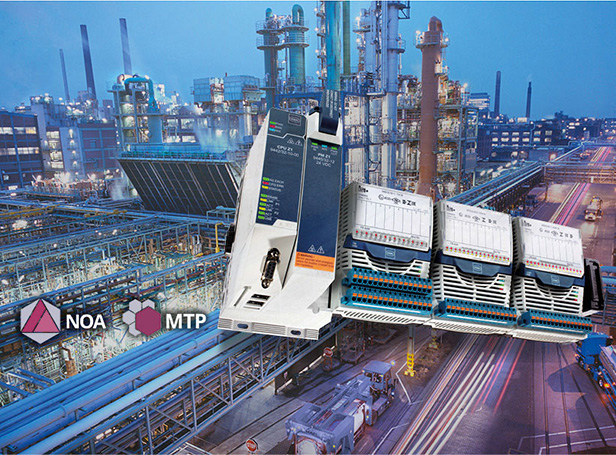Although lighting in industrial plants often only accounts for a small proportion of total energy consumption, it offers considerable potential for savings. The targeted use of modern LED technology and digital lighting management systems – such as those based on the DALI protocol – can permanently reduce energy consumption, maintenance costs and operating costs. The article uses specific practical examples to show how additional efficiency gains can be achieved using presence and daylight sensors as well as automated emergency lighting testing.
Light is more than just lighting – it is a production factor. In industrial plants, it ensures safety, enables precise work and influences concentration and ergonomics. At the same time, it often goes unnoticed during operation – day after day, shift after shift. This is precisely where an often underestimated opportunity lies: Because those who systematically optimise lighting can not only save energy, but also reduce maintenance costs, stabilise processes and improve system availability.
At first, it may seem surprising why automation managers should be concerned with lighting. Because compared to process heat, drive technology or cooling, the proportion of energy seems low. However, optimisation is not only worthwhile for cost reasons, but also because of increasing ESG requirements.
From tubes to LED – the basis for energy efficiency
The basis for an energy-efficient lighting solution is the switch from conventional lighting sources – T8 and T5 fluorescent tubes in particular – to LED technology. Many plants still use conventional lamps such as T8 tubes, which account for around 75 percent of the lighting. This leads to high operating costs and considerable maintenance requirements. In large plants, the lighting often stays on all the time, as the organisational and technical steps required to switch it off are excessive.
LED luminaires are not only more energy-efficient, but also have a longer service life, resulting in significant cost savings during maintenance and operation. The following example makes the potential savings clear: If 50,000 fluorescent lamps with 58 watts each are replaced in a refinery by LED luminaires, more than six million kilowatt-hours can be saved year on year with an average daily switch-on time of twelve hours.
Since the EU-wide phase-out of T8 and T5 tubes in August 2023, the pressure to act has increased significantly. Although there are exceptions for chemical plants in which explosive atmospheres can occur (hazardous areas), a switch to LED lighting is even more worthwhile here in terms of the service life of the lamps and maintenance costs.
Intelligent control as an efficiency lever
The real leverage in terms of energy efficiency, however, is not just in the LED itself, but also in its intelligent control. Modern systems not only detect daylight conditions, but also the presence of people. The light output is then automatically adjusted as required – not only to save energy, but also to reduce wear and tear on the components. This is because dimmed LEDs generate less heat and therefore last longer – often twice as long at full load. The lights can be configured so that they are only active when necessary. In combination with professional lighting design, the number of luminaires can often be reduced or they can be better positioned so that installation costs are reduced and efficiency is maximised.
Theoretically, the following savings can be achieved through various measures:
- 40% of electrical energy can be saved by using retrofit LED solutions: The light source of classic T8 or T5 fluorescent tubes is replaced by an LED lamp.
- 50% of electrical energy can be saved by replacing fluorescent lamps with LEDs.
- Lighting systems in which the LED luminaires are controlled depending on daylight and the presence of operating personnel require up to 70% less electrical energy than conventional fluorescent tubes.
- And a further 10% can be saved if the lighting solution is based on a professional lighting calculation.
Three practical examples in direct comparison
This is true in theory, at least. But are these savings actually achieved in practice? To answer this question, measurements were carried out in three different installations. Electrical measurements were taken at short intervals over a period of a month. The entire lighting system was recorded in two plants and a representative section of a plant in a hazardous area of SIKA-Chemie in Stuttgart.
The central technical component in all three projects is the use of DALI (Digital Addressable Lighting Interface). This standardised, manufacturer-dependent protocol (according to IEC 62386) enables bidirectional communication between luminaires, sensors and control units. DALI works via a simple two-core bus line that can be laid in a star, line or tree shape (ring structures are excluded). Within a DALI circuit, up to 64 addresses can be assigned, allowing each luminaire to be individually controlled, dimmed or monitored. Combined with presence and brightness sensors, daylight-dependent constant light control and presence-controlled scenarios can be implemented. At the same time, DALI enables the centralised feedback of status data – for example, via the luminaire status or test protocols for emergency luminaires. The result is a consistently monitorable, maintenance-friendly and energy-efficient system.
Example 1 – Kuraray Europe, Frankfurt (Germany): Storage tent with use of daylight
In the first practical example at Kuraray Europe, a newly erected storage tent was equipped with a modern lighting management system (LMS). The special structural situation – translucent tent walls – made it possible to make intensive use of daylight. The system was supplemented by six sensors that detect both presence and ambient brightness. In the tent, 24 standardized DALI luminaires and 12 DALI emergency luminaires are installed, which are operated together via a central control system. The energy consumption values were recorded at five-minute intervals over a period of around four weeks (March–April 2025). The comparison was made with a virtual scenario in which the same luminaires would have been operated at 100% output throughout the day without lighting management. The result was an average saving of 94.5% during operating hours. This exceptionally high rate can be explained by the low actual usage time of the room, the high availability of daylight and the automatic dimming via the system.
Example 2 – SIKA Germany, Stuttgart: Highly frequented Ex-Zone
But there are also clear advantages in areas with significantly higher usage intensity. In a second practical example, a production plant (Ex-Zone 1) for filling solvents at SIKA Deutschland in Stuttgart was equipped with a DALI-based lighting management system. A total of 144 DALI luminaires and 58 DALI emergency luminaires were used here, supplemented by 25 sensors that communicated via another system: KNX, a globally established fieldbus system for building automation. DALI and KNX were coupled via a gateway, enabling integrated control. Due to the dense machinery, the use of daylight was severely restricted. The measurement comprised a representative group of luminaires and was carried out over a period of four weeks. Despite almost continuous presence and limited daylight, an average energy saving of 35.6 % was achieved.
Example 3 – R. STAHL, Weimar (Germany): High-bay warehouse with compara-tive measurement
A third project in the high-bay warehouse of the R. STAHL factory in Weimar allowed an even more differentiated evaluation. In this existing facility (brownfield), a comparison was first made between the conventional lighting (mixture of fluorescent tubes and individual LED floodlights) and a modern, newly planned LED system. The new lighting design with exclusively linear LED luminaires initially achieved energy savings of 52% compared to the old system. The implementation of the DALI-based lighting management system – with 122 luminaires in 19 groups and 22 presence and daylight sensors – brought additional savings of 35% on average, resulting in an overall reduction in energy consumption of 87% compared to the original old system. The seasonal difference was particularly remarkable here: While up to 71% of the energy requirement was saved in summer through lighting management alone, the figure in November, when there is less light, was still 63%. All measured values were continuously recorded and validated using industrial power meters.
These practical examples show that the introduction of a lighting management system based on DALI not only enables substantial energy savings, but also increases reliability and reduces personnel costs for maintenance and documentation – especially in safety-critical areas or areas that are difficult to access.
Focus on flexibility and maintenance
However, the potential savings are only part of the truth. The costs of maintenance and operation are much more decisive for many users. The luminaires themselves need to be replaced far less frequently – a particularly relevant point in Ex-Zones, where every replacement process is associated with approval procedures and possibly even a system shutdown. At the same time, the central control system allows lighting zones to be flexibly adapted – for example when restructuring the hall layout. Each luminaire can be addressed, so that changes can be made without rewiring.
Another aspect is particularly relevant for users such as SIKA Chemie (example 2) – the automated testing of emergency lighting systems. According to DIN EN 60598-2-22 and other standards, emergency lighting with individual battery supply must be checked weekly to ensure that it functions correctly. In addition, an annual endurance test must generally be carried out in which the rated operating time is simulated and the behaviour of the luminaire is documented. In conventional systems, this test is performed manually: An employee must physically inspect the luminaires, carry out visual inspections (e.g. read out status LEDs), trigger function switchovers if necessary and then document the results. This process is time-consuming, labour-intensive and error-prone – especially in extensive or difficult-to-access areas such as Ex-Zones.
In contrast, a DALI-based LMS enables fully automated testing and documentation. Each luminaire actively sends its status to the control centre, test runs are triggered on a time-controlled basis (e.g. weekly on Saturdays outside operating hours) and all results are stored in a digital logbook. In the event of deviations or faults, an automated notification can be sent –for example by e-mail or via the building management system. This completely eliminates the need for manual inspections, inspection obligations are fulfilled in accordance with standards and reliability is increased. Last but not least, maintenance can also be better planned: Defective or conspicuous luminaires are specifically identified and do not have to be checked “on suspicion”.
DALI-ready enables investment in stages
It is also important to note that modern systems are modular and the investment can be made in stages: If a DALI-ready luminaire is used in an installation without LMS, it can initially be operated like a normal luminaire. This means that the user has the option to retrofit an LMS at a later date – without having to replace or rewire the system.
Another important aspect for users is that lighting management systems and installations such as those mentioned in the examples do not necessarily require intensive expertise on the part of operating personnel. The scope of delivery starts with planning support and ranges from lighting calculation, commissioning and parameterisation to maintenance. A demo system is also available at the Weimar factory, where the entire system can be tested and experienced in real time – including visualisation, sensor technology and test logging.
Conclusion: Little effort, big impact
Even if lighting is only a small cog in the industrial energy system, it is one with an astonishingly large leverage effect. For those responsible for automation, this offers an attractive opportunity to make a measurable contribution to energy efficiency, sustainability and reliability with little effort.
These articles might also interest you

Ethernet-APL and functional safety – can it work?






![[Translate to Englisch:] [Translate to Englisch:]](/fileadmin/user_upload/mitarbeiter/01_DE/07_Blog/00_Allgemein/blog-explosionsschutz-rstahl-startseite-279x205.jpg)
![[Translate to Englisch:] [Translate to Englisch:]](/fileadmin/user_upload/mitarbeiter/01_DE/07_Blog/00_Allgemein/blog-explosionsschutz-rstahl-ueber-den-blog-279x205.jpg)
![[Translate to Englisch:] [Translate to Englisch:]](/fileadmin/user_upload/mitarbeiter/01_DE/07_Blog/00_Allgemein/blog-explosionsschutz-rstahl-autoren-279x205.jpg)
![[Translate to Englisch:] [Translate to Englisch:]](/fileadmin/user_upload/mitarbeiter/01_DE/07_Blog/00_Allgemein/blog-explosionsschutz-rstahl-newsletter-expert-mail-279x205.jpg)
Write new comment